Copyright © 2016, The Kirchman Studio, all rights reserved
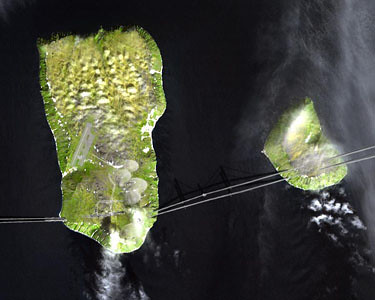
Here in this satellite view of Big Diomede, the biospheres have been added by the artist.
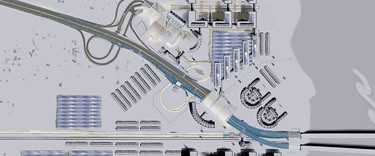
Greenhouses are visible in the Russian Terminus Rendering.
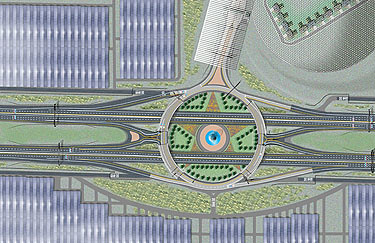
Here is the artist's view of the Big Diomede Biosphere Interchange on A2. Greenhouses and a portion of the biosphere complex are visible, as is the 'Unisphere' recreation that marks the 'End of the World.'
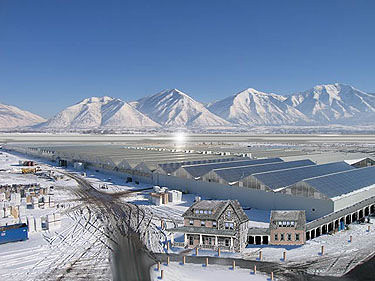
A Concept for a Tundra Greenhouse Farm.
As Joe and Chris had pushed on through the Yukon Territory on A2, they had seen the glimmer of reflected sunlight from Elizabeth's latest initiative... tundra greenhouses. The soil of the tundra had long been known to be extremely fertile but since it was frozen most of the year all that grew there was low scrubby vegetation. Martin pointed out that there was an abundance of geothermal energy in the same vicinity as the fertile tundra. All you had to do was drill for it. With an abundance of oil and gas companies flocking to the region, you simply paid them to sink your wells as a 'side job.' Hot water and steam gushing from deep in the Earth powered turbines to generate electricity, extending the growing season with artificial sunlight. Next it was used to heat the greenhouses and warm the topsoil so it could be cultivated. Finally the cooled water was used to irrigate crops, sinking back into the tundra so the process could be repeated.
Environmental 'protectors' in the lower 48 cried 'foul,' but their own data actually proved you could turn most of Siberia and the Northwest Territories into farms without making a dent in the Earth's temperature balance. The change was not without precedent. In the late Nineteenth Century the American West had been transformed into the breadbasket of the world. Immigrants fleeing famine joined with adventure seekers and restless pioneers to build this new world. Disney's Main Street was but a faint allusion to the energy of these communities as they had faced the frontier with little else than determination and faith. Faith, in the end, was the nutrient that kept them strong. Rupert's shipbuilding friends were happy to fabricate greenhouses fit to withstand the snow loads as his great bridge and the support buildings necessary for it were nearing completion. His Swedish friend followed in the path of Sears Roebuck in providing fine houses for the pioneers. On Martin O'Malley's drawing boards were plans for a new world to take shape in the Twenty-first Century. A world wracked by war and famine eagerly awaited it.
Elizabeth's vision would bring people presently crammed into refugee camps to work the soil inside her greenhouses. The Bering Strait highways would become a conduit for them to feed their homelands. All this would require the participation of thousands of souls who would plant, cultivate, harvest, drive trucks and provide necessary services for those involved in these activities. Coptic Egyptians, now living free of persecution, populated one of the first villages. Their rich Orthodox Church seemed right at home among the vestiges of Russian America. Sumatran Muslims who had made their fortunes working away from home on cruise ships now were able to make a living with their families intact in their own little community.
Elizabeth followed the example of Nineteenth Century America in broadcasting the little groups in such a way that they would need to cooperate with other communities while they enjoyed the familiarity of their own. Perhaps ths sharing in taming hostile wilderness is one of the Divine's greatest gifts to mankind in that they learn to work together. Joe and Chris had stopped to help Abdul change a tire earlier in the day. Men of two different cultures, they were brought together by a common struggle -- the struggle for survival on that hostile road. Chris had never spent time with a Turk before, but Joe remembered when his Grandfather, a NASA engineer in the 1960's had worked with a man from Ankarah named Ali. Ali was the son of Turkish immigrants and was a fellow engineer. Joe's Grandmother had learned what foods to avoid serving as the men shared each other's homes in hospitality." -- From PONTIFUS
Copyright © 2016, The Kirchman Studio, all rights reserved
The vision for Arctic farming has been shared in articles such as this one: Farming in the Arctic, It Can Be Done [click to read]. At the present it is not done on a large scale, but projects such as one proposed to build geodesic domes in the Nunavut community of Pangnirtung suggest the idea has merit. While greenhouse farming is done successfully in the Alaskan community of Bethel, a government program to encourage such farming was pretty much a disaster. In any case, the geothermic heated greenhouses in PONTIFUS [click to read] offer the vision of a new frontier, right down to the 'next' generation of 'Sear's Roebuck Houses.' In them, it is envisioned that the isolation would allow for a more organic agriculture and almost no use of chemicals.

There is a proposal to build geodesic domes such as these in the Nunavut community of Pangnirtung.
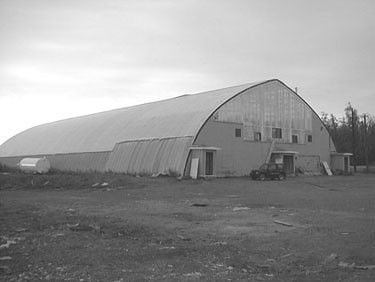
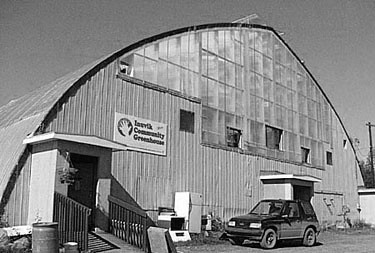
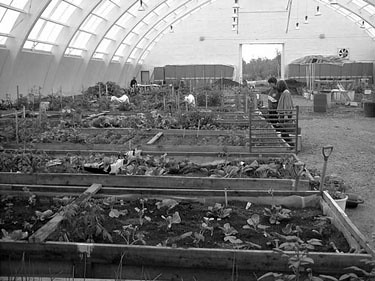
A greenhouse now on the tundra.